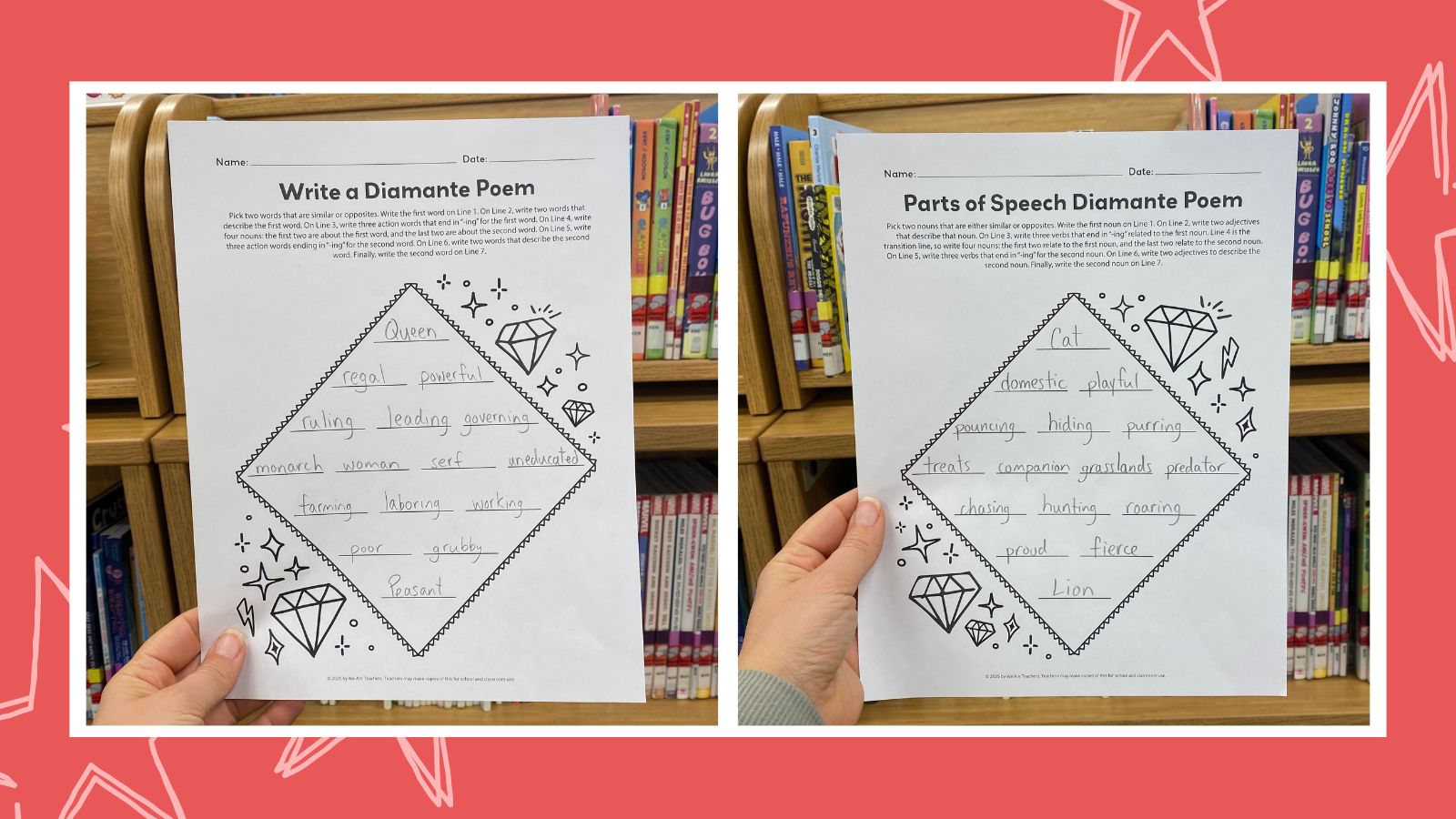Diamante poems are a fun way to explore opposites, relationships, and contrasts within a simple, structured format. In just seven lines, these diamond-shaped poems pair distinct ideas in creative ways.
Here we’ll walk you through the steps to create a diamante poem, share examples for inspiration, and provide a free printable template to spark your students’ creativity.
Plus, fill out the form on this page to receive our free printable bundle with five worksheets to use for all of the diamante poems below!
Diamante Poems Explained
A diamante poem is a seven-line poem that takes the shape of a diamond. The word diamante comes from the Italian word for “diamond,” which reflects the poem’s shape. It’s designed to explore contrasts, relationships, or opposites using concise, powerful language, making it a great tool for students to practice descriptive writing.
Diamantes don’t need to rhyme, and they come in two types: synonym diamantes (where the beginning and end nouns are similar) and antonym diamantes (where the beginning and end nouns are opposites).
The Rules of a Diamante Poem
- Seven lines total.
- The first and seventh lines have one word (noun).
- The second and sixth lines have two words (adjectives).
- The third and fifth lines have three words (verbs ending in -ing).
- The fourth line has four words (this is the transition line, so the first two words must relate to the word in Line 1 and the second two words will relate to the word in Line 7).
This structure is visually engaging and educational, reinforcing students’ understanding of synonyms and antonyms in a creative way.
How To Write a Diamante Poem
Engage kids in writing their own eye-catching diamante poems with these simple steps.
Step 1 – Pick Two Opposite or Related Nouns
Choose two nouns that are either opposites or related. For example, for an antonym diamante, “sun” and “moon” or “dog” and “cat” are great choices. For a synonym diamante, “flowers” and “tulips” or “puddle” and “ocean” work. These two nouns will be the focus of the poem, helping to highlight their relationship.
Step 2 – Brainstorm Related Words
Brainstorm adjectives, verbs, and phrases related to the two chosen nouns. Create a list of words that describe the nouns, focusing on the qualities, actions, and emotions they evoke. This will help establish a strong foundation for writing the poem.
Step 3 – Follow the Diamante Structure
Diamante poems follow a specific structure, with a set number of words used to describe two opposing or related nouns. Use this simple structure to guide the creation of a diamante poem:
- Line 1: Noun (subject 1)
- Line 2: Two adjectives describing Line 1
- Line 3: Three action verbs ending in -ing related to Line 1
- Line 4: Four nouns (this is the transition line, so the first two words must relate to subject 1, and the second two words will relate to subject 2 in Line 7.)
- Line 5: Three action verbs ending in -ing related to Line 2
- Line 6: Two adjectives describing Line 2
- Line 7: Noun (subject 2)
Step 4 – Write the Poem
Start writing your diamante poem using the structure from Step 3 and the brainstormed words from Step 2. Focus on creating a smooth flow from Line 1 to Line 7. Think about how the words transition between the first and second subjects.
Step 5 – Add Final Touches
Once the poem is written, review it. Are there any stronger word choices that could enhance the poem? Does it highlight the relationship or contrast between the two nouns? Make adjustments to improve flow, spacing, and word choice for a more impactful final piece.
Diamante Poem Examples and Templates
These examples help students visualize what they’ll be creating while inspiring creativity. They demonstrate how two words can be connected or contrasted with precision, making this an engaging activity for elementary, middle, and high school students.
Free Printable Diamante Poem Templates
Need help getting started? Download our free templates to guide your students in creating diamond-shaped poems. Just click the button below to get our free printable bundle featuring worksheets for all five of the poem examples above.






